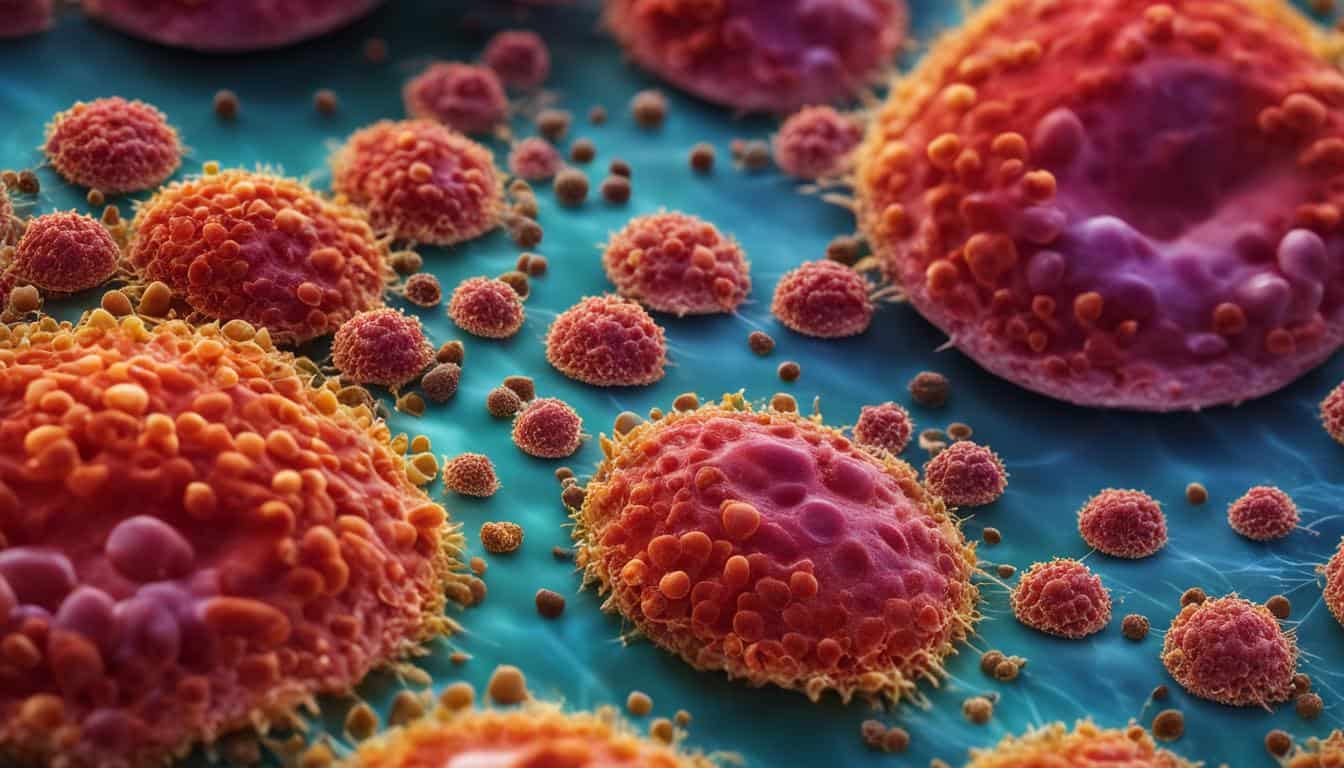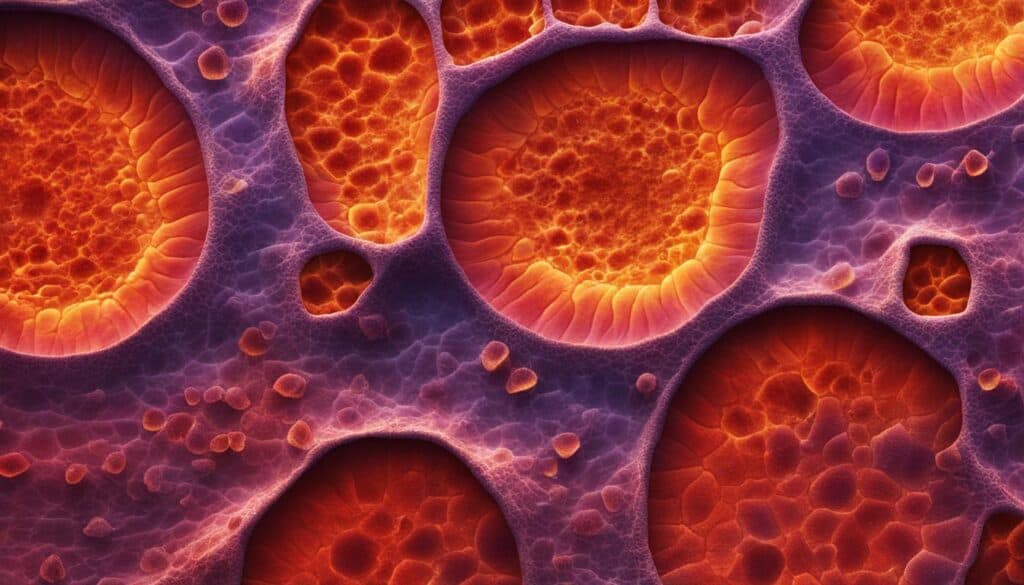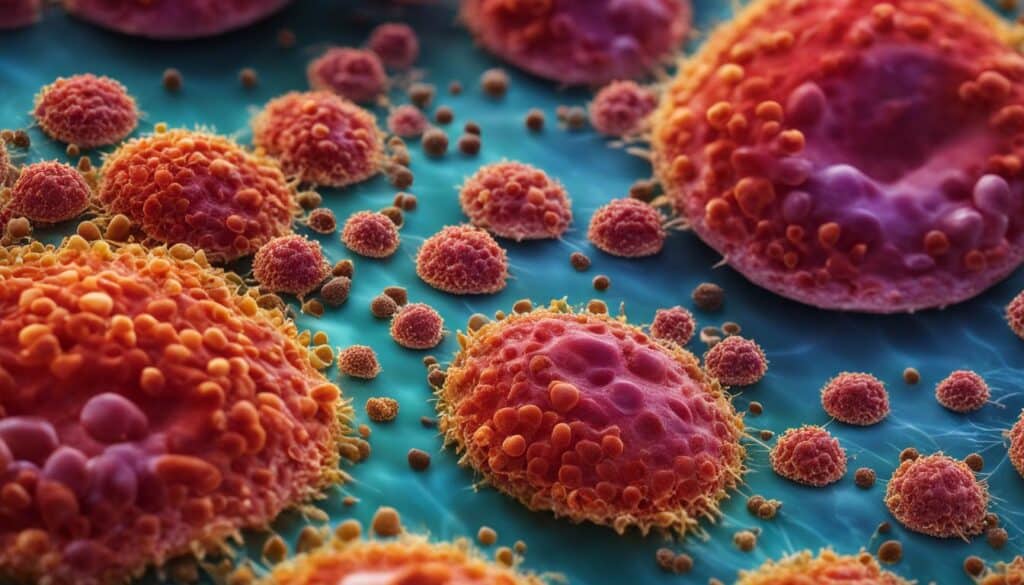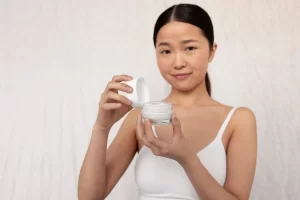
Skin Cell Turnover for Effective Sun Damage Repair. When it comes to healthy skin, cell turnover is a crucial process that shouldn’t be neglected, particularly for those who have spent time in the sun. Skin cell turnover refers to the rate at which new skin cells are produced, replacing older ones that naturally shed from the skin’s surface. For those who have experienced sun damage, cell turnover is especially important as it can aid in repairing UV-damaged skin cells and promoting healthier, more youthful-looking skin.
Show a close-up view of skin cells undergoing turnover and repair after sun damage. Use warm colors to depict healthy, new skin cells replacing damaged ones, and cooler colors to show the damaged cells being removed and replaced. Add small details like sun rays hitting the skin and small debris being carried away by blood vessels to add depth to the image.
- Skin cell turnover is essential for healthy, rejuvenated skin.
- Sun damage can be repaired through accelerated skin cell turnover.
- Promoting skin cell turnover through exfoliation and other treatments can lead to a healthier-looking complexion.
- Regular skin renewal can reduce the signs of sun damage and restore a youthful appearance.
- Adopting skincare practices that promote skin regeneration and rejuvenation can help to counteract the damaging effects of the sun on the skin.
Understanding Skin Cell Turnover
Healthy skin relies on the regular process of skin cells shedding and being replaced by new ones. This natural process is known as skin cell turnover, and it plays a significant role in the skin’s overall health and appearance. Understanding how this process works is key to promoting healthy, rejuvenated skin, particularly in repairing sun damage.
During skin cell turnover, old cells located in the stratum corneum – the outermost layer of skin – flake off and are replaced by new cells that migrate from deeper layers of the epidermis. The frequency and rate of cell turnover vary depending on several factors, including age, genetics, and environment. The process can take anywhere from several days to a few weeks.
Factors that can influence the rate of cell turnover include sun exposure, smoking, pollution exposure, and harsh topical products. These factors can slow down the process of shedding old, dead skin cells, leading to a buildup of cells and dull, uneven skin tone. Thus, enhancing cell turnover is crucial for promoting healthy, rejuvenated skin.
In addition to promoting a healthy complexion, optimizing skin cell turnover can also have anti-aging benefits. As skin ages, the process of turnover slows down. Regular exfoliation and the use of retinoids can boost cell renewal and lead to a smoother, more youthful appearance.
Enhancing skin cell turnover can rejuvenate the skin and promote a healthier complexion.
Sun Damage and Its Effects on the Skin
The harmful effects of the sun on the skin cannot be overemphasized. Prolonged exposure to UV radiation can cause sunburn, premature aging, and sunspots. These effects are mainly due to the damage caused to the skin’s collagen and elastin fibers, which affects the skin’s elasticity, leading to wrinkles, sagging skin, and an uneven skin texture. Sun damage can also lead to the development of skin cancer.
Effective repair and rejuvenation of sun-damaged skin require a multifaceted approach. It is essential to promote skin cell turnover, which can help eliminate damaged skin cells and replace them with new, healthy ones. This process promotes collagen production and can significantly improve the skin’s overall look and feel.
Repairing Sun Damaged Skin
Sun-damaged skin needs regular repair and rejuvenation to reduce the risk of long-term damage. The most effective approach involves promoting skin cell turnover to remove damaged cells and enhance collagen production. Professional skin treatments like chemical peels and microdermabrasion can help to speed up the skin’s natural cell turnover process while improving the skin’s tone and texture.
At-home treatments are also essential for maintaining healthy, sun-damaged skin. Retinoids and other vitamin A derivatives can stimulate cell turnover, while antioxidants like vitamin C and E can help to neutralize free radicals that can cause further damage. Exfoliating regularly can also help to remove damaged skin cells and promote renewal.
“Sun damage can be a complicated issue. It can take years to develop underneath the skin’s surface and can show up suddenly, making it a tough condition to treat.” – Dr. Rachel Nazarian
Preventing further sun damage is crucial in any repair process. Limiting sun exposure, wearing protective clothing, and using a broad-spectrum sunscreen with at least an SPF of 30 can go a long way in preventing further UV damage.
The Role of Skin Regeneration in Sun Damage Repair
Repairing UV-damaged skin requires the activation of the skin’s natural regeneration process. It helps to create new skin cells and provide better protection against further sun damage. Skin regeneration is crucial for repairing sun damage since it enhances the skin’s ability to heal and repair.
During regeneration, damaged cells and tissues are replaced with new ones, promoting skin cell renewal and rejuvenation. In addition, skin regeneration helps to increase collagen production, which in turn improves skin elasticity and firmness.
Effective sun damage repair involves promoting skin regeneration, and a proper skincare routine can help achieve that. For instance, Serums that contain skin-renewing ingredients, such as glycolic and lactic acid, help in skin regeneration. These ingredients stimulate cell turnover and help to remove dead skin cells, promoting the growth of new ones.
Moreover, Retinols, which are another form of Vitamin-A, are known to aid in skin regeneration and repairing UV damage. It stimulates cell growth and promotes the production of collagen. In this way, retinol helps to reduce the appearance of wrinkles and fine lines and improve skin texture and tone.
Overall, Skin regeneration plays a significant role in sun damage repair and can help restore a youthful glow and healthier-looking complexion. It is crucial to promote skin cell turnover by following a skincare routine that supports skin regeneration, thereby repairing UV-damaged skin cells and promoting skin health.
Promoting Skin Cell Turnover for Sun Damage Repair
To repair sun damage and promote healthy skin, it is essential to enhance skin cell turnover. This can be achieved through a range of techniques and practices, each helping to rejuvenate the skin and boost its natural renewal process.
Exfoliation: One of the most effective methods for promoting skin cell turnover is through regular exfoliation. This process involves removing dead skin cells from the surface of the skin, allowing new cells to form and replacing the old, damaged ones. Exfoliation can be achieved through physical scrubs, chemical peels, or exfoliating brushes.
Retinoids: Retinoids are a type of vitamin A that can help to stimulate skin cell turnover and promote skin rejuvenation. These potent compounds can help to reduce the appearance of fine lines and wrinkles, improve skin texture and tone, and repair sun damage. Retinoids can be found in over-the-counter skincare products, or in prescription-strength formulations for more significant sun damage.
Other Skincare Treatments: Other skincare treatments, such as chemical exfoliants, facials, and light therapy, can also help to promote skin cell turnover and repair sun damage. Chemical exfoliants, such as alpha-hydroxy acids (AHAs) and beta-hydroxy acids (BHAs), work by dissolving dead skin cells and promoting skin renewal. Facials can help to exfoliate and hydrate the skin, while light therapy can help to reduce the appearance of sunspots and promote skin rejuvenation.
“Promoting skin cell turnover through exfoliation, retinoids, and other skincare treatments can help to repair sun damage and rejuvenate the skin.”
Key Takeaways:
- Promoting skin cell turnover is essential for repairing sun damage and promoting healthy skin.
- Exfoliation, retinoids, and other skincare treatments can help to enhance skin cell turnover and promote skin rejuvenation.
- Regular use of these techniques can lead to a more youthful and healthier complexion, with improved skin texture and reduced signs of sun damage.
Rejuvenating the Skin for a Healthier Complexion
Regular skin renewal plays a crucial role in achieving a healthier complexion and reducing the signs of sun damage. By promoting skin rejuvenation, you can enhance your skin’s natural renewal process, leading to a brighter, smoother, and more radiant appearance.
There are numerous techniques that can help promote skin renewal. One of the most effective ways is through exfoliation. Exfoliating removes dead skin cells, allowing new ones to come to the surface and enhancing the overall appearance of your skin. It is essential to choose the right kind of exfoliation method for your skin type to avoid irritation or damage.
Another powerful tool for promoting skin rejuvenation is through the use of retinoids. Retinoids are vitamin A derivatives that stimulate skin cell turnover, leading to healthier, more youthful skin. They are known to be effective in reducing the appearance of fine lines, wrinkles, and sun damage.
“Using a retinoid product is like whipping your skin cells into shape. They stimulate cell division and repair, making it one of the best ingredients to reduce sun damage.” -Dr. Loretta Ciraldo, MD, FAAD
Other effective skincare treatments that promote skin renewal include chemical peels, microdermabrasion, and laser treatments. These treatments can help reduce the appearance of sunspots, minimize pore size, and enhance skin texture. It is advisable to seek professional advice before undergoing any of these treatments, as they can be intense, and the results can vary from person to person.
By promoting skin renewal, you can achieve a healthier, more youthful-looking complexion. It is essential to develop a good skincare routine that includes regular exfoliation, the use of suitable skincare products, and seeking professional advice when necessary. With the right techniques and practices, you can rejuvenate your skin and reduce the signs of sun damage for a more radiant and beautiful you.
Conclusion:Skin Cell Turnover for Effective Sun Damage Repair
In conclusion, achieving effective sun damage repair requires understanding and enhancing the skin’s natural process of cell turnover. Through regular skin renewal, dead skin cells are eliminated, and new ones take their place, resulting in a healthier and more youthful complexion.
To promote skin rejuvenation and repair, it is important to adopt healthy skincare habits such as regular exfoliation, use of retinoids, and other treatments that stimulate skin cell turnover.
By incorporating these practices into your skincare routine, you can effectively repair and rejuvenate sun-damaged skin, resulting in a healthier and more radiant appearance.
Remember, taking care of your skin is an ongoing process, and consistency is key. With patience and dedication, you can see a noticeable improvement in your skin’s texture and appearance while reducing the harmful effects of sun damage.
FAQ
What is skin cell turnover?
Skin cell turnover is the process by which old skin cells are shed and replaced with new cells. It is a natural regeneration process that helps to maintain the health and appearance of the skin.
How does skin cell turnover repair sun damage?
Skin cell turnover plays a crucial role in repairing sun damage by shedding damaged skin cells and replacing them with healthy new cells. This process helps to reduce the appearance of sunspots, fine lines, and wrinkles caused by UV exposure.
What factors can influence the rate of skin cell turnover?
Several factors can affect the rate of skin cell turnover, including age, genetics, lifestyle habits, and environmental factors. For example, younger individuals typically have faster cell turnover than older individuals.
How does sun damage affect the skin?
Sun damage can have various detrimental effects on the skin, including premature aging, the formation of sunspots, uneven skin tone, and an increased risk of skin cancer. It is essential to repair and rejuvenate sun-damaged skin to maintain a youthful and healthy complexion.
How does skin regeneration help repair UV damage?
Skin regeneration is the natural process by which the skin repairs and replaces damaged cells. It helps to heal UV-damaged skin cells, promoting the growth of new, healthy cells. This repair process can improve the skin’s texture, elasticity, and overall appearance.
How can I promote skin cell turnover for sun damage repair?
To promote skin cell turnover, incorporate regular exfoliation into your skincare routine. Exfoliation helps to remove dead skin cells and stimulate the renewal process. Using skincare products with retinoids can also enhance cell turnover and repair sun damage.
What are the benefits of rejuvenating the skin through cell turnover?
Rejuvenating the skin through enhanced cell turnover can result in a healthier complexion, improved skin texture, reduced signs of sun damage, and a more youthful appearance. It can also increase the effectiveness of skincare products by allowing them to penetrate deeper into the skin.
Related posts that you may be interested: “Revitalize Skin with Cell Turnover and Hydration“








